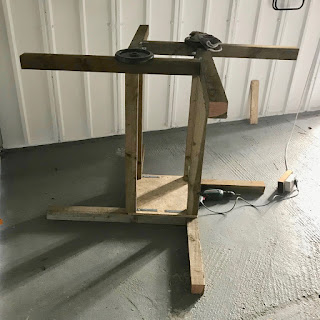Mock the thing up at full-scale with 75mm square timber that I knock down at the local yard for £25 instead of £38.90 in view of its weathered condition. Actually it doesn't look that bad anyway, but I won't be telling them any time soon. The 1/5th scale model that you see on the website used 12mm spars and so the lumber is oversize, but as you'll recall we wanted to stack the base with lithium-ion cells and they're around 62mm long.
What the exercise probably proves is that it's stupid to design airframe around the batteries instead of the passengers, although in fairness in electrical vehicles the batteries loom large. Wouldn't be the first time too ~ Bristol designed their Britannia turbo-prop for three dozen passengers, because British Airways (as BOAC) said that was how many their buses seated.
Meanwhile the CAD/CAM nerds should bear in mind that every new design of car is mocked up at full size in (latterly) timber and clay or else (currently) 3-D printed plastic, because you can never be sure of how people will react to the finished product. How the Edsel or Scorpio (or indeed the Renault Megane) slipped through the net at this stage is anyone's guess.
Soon as I start the build I am unhappy, firstly because being rough timber it catches threads on my pullover: must sort that out in the production version. It also looks lumpen and first chance I get I shall take the timber back for planing, either to 50mm or else 60mm. Former is favourite as it broadly works in Imperial measure as well as Metric, plus it provides room to swing a cat in the passenger compartment.
The dozen spars are an identical metre and hang together nicely in terms of ergonomics. Immediate problem that springs to mind is ingress, or how to get in. In theory you could climb in the top, but if you ever try drinking and climbing into a wheelie-bin, as most Brits do, you'll know it's a recipe for a broken neck.
The upper spar that bars entry around abdomen-level could be hinged or telescoped so as to be swung or slid out of the way, but I prefer 'solid-state' construction without moving parts.
You'll recall that swing-wing aircraft were generally still-born like the scissor-wing, else sold in restricted markets like BAE's Tornado. The F-111 sold 563, but then again the F-16 sold 4604 to date. Reason being, hinges are heavy, expensive and difficult to manufacture or fix.
You'll recall that swing-wing aircraft were generally still-born like the scissor-wing, else sold in restricted markets like BAE's Tornado. The F-111 sold 563, but then again the F-16 sold 4604 to date. Reason being, hinges are heavy, expensive and difficult to manufacture or fix.
I do have a solution and I think you'll like it as much as I do.
Days in the workshop ~ no matter how bad ~ pay dividends.
Days in the workshop ~ no matter how bad ~ pay dividends.
